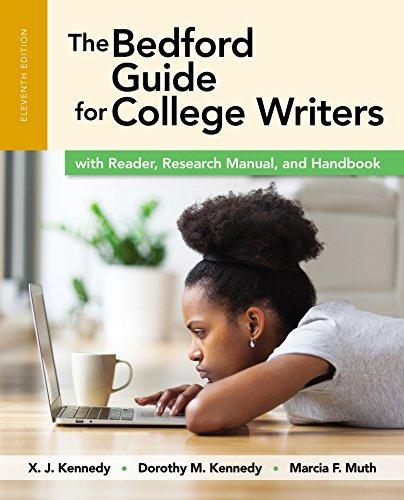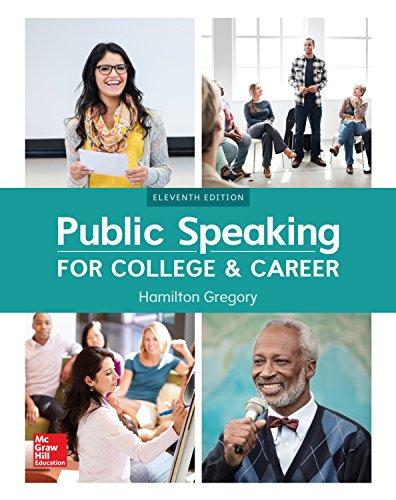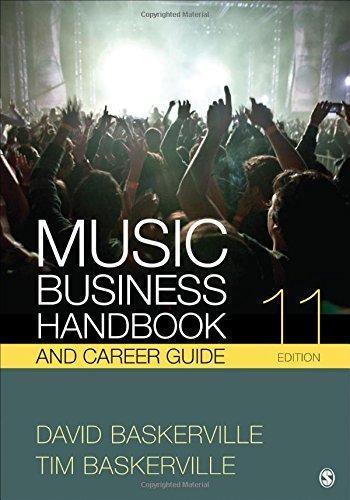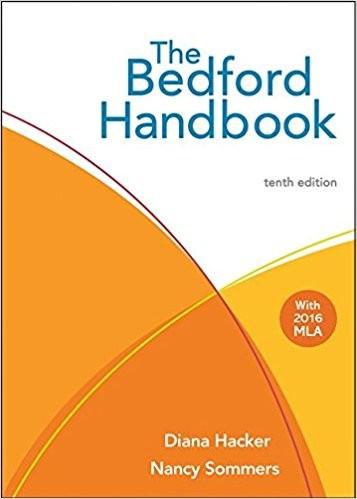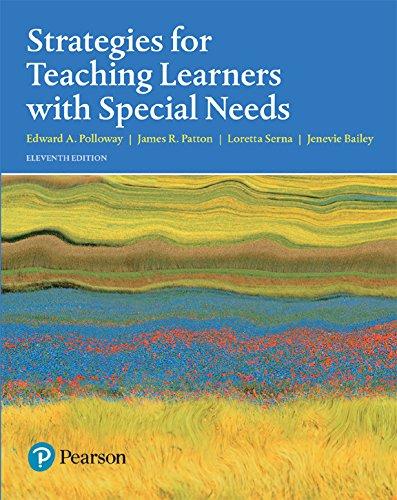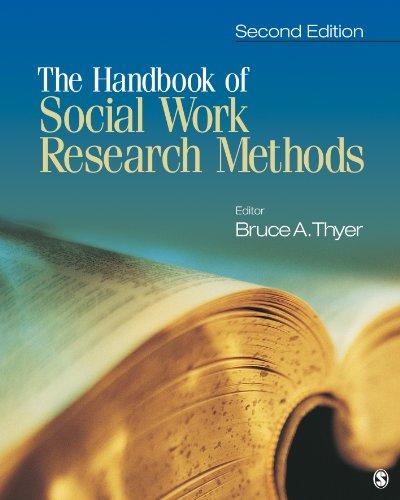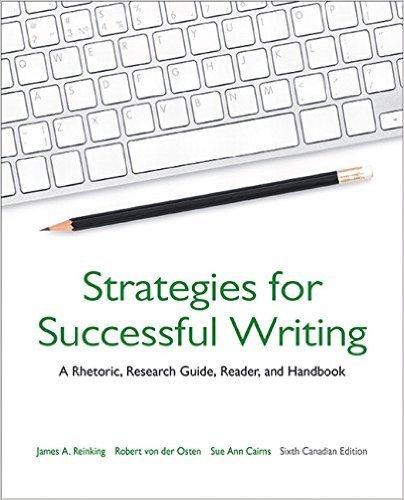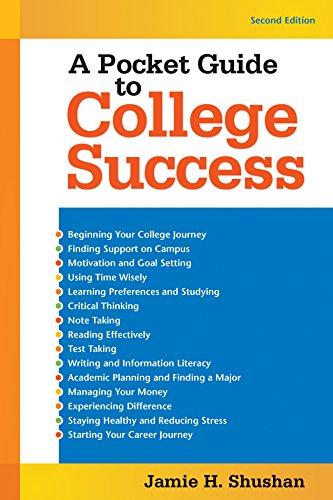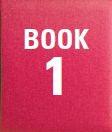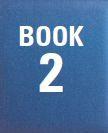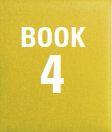Preface TO THE INSTRUCTOR
The eleventh edition of The Bedford Guide for College Writers gives students all the tools they need to succeed as writers, especially in the rapidly changing times in which we now live and write. Whether their writing class meets on campus or online, students benefit from qualities integral to The Bedford Guide’s enduring success clear and succinct instruction, thorough coverage with a flexible organization, and frequent opportunities for active learning, engaging students with what is presented. The eleventh edition extends active learning into the realm of reflection, offering students more opportunities to build deeper awareness of their own writing processes. All aspects of this new edition of The Bedford Guide are designed with one overarching goal: to help students to become the confident, resourceful, and independent writers they will need to be.
Several key interrelated ideas have shaped this book from the beginning. First, students learn best by doing. The Bedford Guide therefore includes an exceptional number of opportunities for practice and self-assessment. Throughout the book, we intersperse class-tested Learning by Doing activities and assignments in a helpful rhythm with concise instruction and models of writing. Students have frequent opportunities to apply what they’ve learned and become comfortable with each step in the process as they go along.
Second, we intend The Bedford Guide for College Writers to be an effective, engaging text that gives students everything they need to write well all in one flexible book. Written and developed as four books in one, it offers a process-oriented rhetoric, a provocative thematic reader, an up-todate research manual, and a comprehensive handbook. The Bedford Guide gives students all the tools they need to succeed as writers.
Most importantly, the focus of the book is building transferable skills. Recognizing that the college composition course may be one of a student’s last classes with in-depth writing instruction, we’ve made every effort to ensure that The Bedford Guide develops writers capable of meeting future challenges. To this end, the book offers supportive, step-by-step guidance; Why Writing Matters features; a full chapter on Strategies for Writing in Future Courses; and varied, end-of-chapter Additional Writing Assignments. These and other features prepare students to apply what they’ve learned in other courses and in the workplace, meeting whatever rhetorical challenges lie ahead, in college and in life.
Built on these cornerstone concepts, the tremendous success of The Bedford Guide has been gratifying. Especially gratifying has been the way that this book has continued to evolve over time. New ideas on teaching and writing and excellent suggestions from users of the book improve and enrich each edition. In addition to incorporating the many new features and topics discussed in detail on pages viii–xi, the eleventh edition expands on popular features, offering many new class-tested Learning by Doing activities and new Take Action charts on focusing a research question, evaluating sources, avoiding plagiarism, and improving word use. These changes and others throughout the book do even more to involve students in their own development as writers.
Everything You Need
The eleventh edition continues to offer four coordinated composition books integrated into one convenient text all of them now even better resources for students. The Bedford Guide is also available in a brief version, containing the rhetoric and reader, and as a PDF e-book.
The eleventh edition is also available in LaunchPad, Macmillan Learning’s online course space. Here, you’ll find pre-built units corresponding to the book chapters that you can customize or assign out-ofthe box. In addition to a full interactive e-book, the LaunchPad includes multimodal readings, additional Learning by Doing activities, automatically scored reading comprehension quizzes for the readings in Books 1 and 2, and automatically scored chapter review quizzes that are part of the new Reviewing and Reflecting feature in Parts Two and Three in Book 1. The LaunchPad also includes downloadable lecture slides.
A Writer’s Guide
This uniquely accessible yet thorough process-oriented rhetoric helps students become better writers, regardless of their skill level. Addressing all the assignments and topics typically covered in a first-year writing course, it is divided into four parts.
Part One, A College Writer’s Processes, introduces students to the interconnected processes of writing (Chapter 1), reading (Chapter 2), and critical thinking (Chapter 3). In the eleventh edition, Chapter 3 now introduces students to metacognition and reflection and includes a sample student self-reflection responding to a midterm reflection prompt. This new section prepares students for the many new opportunites for reflection they’ll encounter throughout the book.
In Part Two, A Writer’s Situations, nine core chapters each including two sample readings (one by a student) guide students step-by-step through a full range of common first-year writing assignments. The rhetorical situations in Part Two include recalling an experience (Chapter 4), observing a scene (Chapter 5), interviewing a subject (Chapter 6), comparing and contrasting (Chapter 7), explaining causes and effects (Chapter 8), taking a stand (Chapter 9), proposing a solution (Chapter 10), evaluating and reviewing (Chapter 11), and supporting a position with sources (Chapter 12). If followed sequentially, these chapters lead students through the types of rigorous analytical writing that will comprise most of their college writing. Rearranged and selected chapters readily support a course emphasizing argument, source-based writing, or other rhetorical or thematic approaches.
Part Three, Other Writing Situations, offers helpful strategies and examples to focus students’ efforts in five special rhetorical situations: responding to literature (Chapter 13), responding to visual representations (Chapter 14), writing online (Chapter 15), writing and presenting under pressure (Chapter 16), and writing in the workplace (Chapter 17).
Part Four, A Writer’s Strategies, is a convenient resource for approaching different writing processes. The first chapter, Strategies: A Case Study (Chapter 18), follows a student as she develops and revises her “recalling an experience” paper through multiple drafts. It also includes her self-reflective portfolio letter. The next five chapters explain and further illustrate stages of common writing processes: generating ideas (Chapter 19), stating a thesis and planning (Chapter 20), drafting (Chapter 21), developing (Chapter 22), and revising and editing (Chapter 23). Marginal annotations in the earlier parts of
the book guide students to these chapters, which collectively serve as a writer’s toolbox. The part ends with Chapter 24, Strategies for Writing in Future Courses. This revised, more sharply focused chapter includes guidelines for writing in a variety of disciplines including nursing and business and features a new sample psychology assignment and student response.
A Writer’s Reader
A Writer’s Reader is a thematic reader, unique in a book of this kind. The reader offers 24 selections in all half of them new arranged around five themes that provide a meaningful context for students, giving them something to write about. The themes are Family (Chapter 25), Gender (Chapter 26), Popular Culture (Chapter 27), Language (Chapter 28), and the Good Life (Chapter 29). This last distinctive theme considers what different people value as components of a life well lived. Apparatus that encourages critical thinking and writing accompanies each reading. A rhetorical table of contents (p. xxxiii) shows how selections correlate with A Writer’s Guide and the writing situations assigned there. A biographical headnote and a brief prereading tip or question introduce each reading. Each selection is followed by questions on meaning, writing strategies, critical reading, vocabulary, and connections to other selections; journal prompts; and suggested writing assignments, one personal and the other analytical. These questions lead students from reading carefully for both thematic and rhetorical elements to applying new strategies and insights in their own writing.

A Writer’s Research Manual
A Writer’s Research Manual is a remarkably comprehensive guide to source-based writing, detailing all the essential steps for print, electronic, and field research. Updated and reorganized to prepare students who may be completing smaller research segments in place of or in addition to a longer research paper, this manual covers defining the research project (Chapter 30), finding sources (Chapter 31), evaluating sources (Chapter 32), working with sources (Chapter 33), integrating sources (Chapter 34), and writing the research paper (Chapter 35). The eleventh edition includes new assignments on creating research proposals, source evaluations, and an annotated bibliography, as well as a new section on popular versus scholarly sources,
expanded coverage of working with Internet sources, and new Source Navigators, Take Action charts, and Learning by Doing activities. Chapters 36 and 37 include extensive coverage of MLA and APA documentation, with ninety-eight MLA-style models reflecting the 2016 MLA update and over seventy APA-style models. In the appendices, a Quick Research Guide conveniently and briefly reviews how to find, evaluate, integrate, cite, and document sources. Here also, a Quick Format Guide illustrates academic document design.
A Writer’s Handbook
A comprehensive handbook clearly explains grammar, style, and usage topics and contains guidelines for multilingual writers. The eleventh edition Handbook features a fresh new design, opens with a Learning by Doing activity that introduces students to error logs, and includes a new chapter covering basic grammar (Chapter 38). It also includes nearly fifty exercise sets for practice in and out of class. Answers to half the questions in most sets are provided at the end of the Handbook so that students can check their understanding. Beyond the coverage in the Handbook, a Quick Editing Guide in the appendices gives special attention to the most troublesome grammar and editing problems.
New to the Eleventh Edition
The eleventh edition gives students even more opportunities for learning by doing and developing transferable skills. Through innovative activities, assignments, visuals, readings, and examples of students’ work, this new edition prepares students for writing challenges in college and beyond. New readings and visuals engage students in contemporary issues, and activities reflect classroom experiences, advances from the always developing field of composition, and the insightful suggestions of many helpful reviewers.
Focus on Reflection
Emphasis on Reflection as a Critical Thinking Process. Throughout the eleventh edition, we’ve created a framework to help students reflect on their progress as writers and to develop a deeper awareness of their processes that they can carry with them as they move into future courses and the workplace. A new
section in Chapter 3, Critical Thinking Processes, sets the stage for this focus, introducing students to the concepts of metacognition and reflection and explaining their value to writers. The chapter also includes a sample student reflection with questions for analysis, as well as a series of reflection prompts to which students can return as they complete assignments in the text.
Reviewing and Reflecting Activities. Each chapter in Part Two, A Writer’s Situations, and Part Three, Other Writing Situations, now concludes with a new Reviewing and Reflecting feature that lives both in the book and in LaunchPad. The Reviewing portion assesses students’ comprehension of key concepts in the chapter through short-answer questions. In LaunchPad, these questions are supplemented by a series of automatically graded questions. The Reflecting portion of the feature prompts students to assess their experience completing assignments in the chapter and to extend that assessment to hypothetical writing situations they may face in the future.
Reviewing and Reflecting
REVIEW Working with classmates or independently, respond to the following questions:
1. What are some strategies for finding an interesting interview subject? Using one or more of these strategies, identify two or three possible interview candidates.
2. Once you have conducted an interview, what strategies can you use to evaluate the information that you’ve gathered and identify the most useful material?
3. In interview-based personal profiles, what should the thesis do? Examine the thesis in a personal profile one written by you or a peer, or by a journalist. Does it accomplish this goal? Why, or why not?
REFLECT After completing one of the writing assignments presented in this chapter or supplied by your instructor, turn back to the After Writing questions on page 39 of Chapter 3 and respond to as many of them as you can.
Next, reflect in writing about how you might apply the insights that you drew from this assignment to another situation in or outside of college in which you have to conduct an interview. If no specific situations come to mind, imagine that in a business course, you have decided to interview an entrepreneur about how he or she achieved success. in a work setting, you have been asked to interview a top executive for a profile in your company’s newsletter.
Many New Class-Tested Learning by Doing Activities, with an Emphasis on Reflection. Nearly a third of the Learning by Doing activities in the book and LaunchPad are new, and all new activities have been class-tested. One-fifth of the activities focus on reflection a greater percentage than before. New activities encourage students to reflect on everything from their writing spaces, to grades and feedback in prior courses, to their preparation for writing in various disciplines.
Error Log Coverage in the Handbook. The eleventh edition’s emphasis on reflection extends to A Writer’s Handbook, which now opens with a Learning by Doing activity that helps students design an error log to help them better identify and improve upon trouble spots in their writing.
Learning by Doing Creating an Error Log
Keeping track of errors will dramatically improve your writing skills. Whether you use a paper notebook or a computer file, maintain a running list of corrections made on your drafts by your instructor or writing tutors. Keep track of the date, the name of the error and its symbol or abbreviation (“pronoun agreement / pn agr”), a sample sentence or word group, and a note about how to fix the mistake. You may also wish to note the type of error: matters of grammar are addressed in Chapter 39, style is covered in Chapter 40, word choice is in Chapter 41, punctuation is in Chapter 42, and mechanics are in
Chapter 43. If you are unsure of the meaning of a grammatical term, check Chapter 38 for a review of common elements such as parts of speech or look in the index for specific page numbers.
Guidance on Writing in Future Courses
Chapter 24 has been refocused on writing for future courses and provides specific guidance on writing in the sciences, nursing, the arts, business, education, history, and psychology. The chapter includes a new sample critical thinking assignment for a developmental psychology course, and a student’s response, with questions for analysis.
Timely New Readings and a New Chapter on Language in A Writer’s Reader
28 Language
Krystyna Szulecka/Alamy.
Responding to an Image
546
Jaume Plensa is a sculptor and artist from Spain. His installation 29 Palms, shown above, is a 164-foot curtain composed of steel-cut letters comprising his favorite poems. The letters are designed to cast fluid shadows across the wall and floor. In the photo, a visitor touches the letters to make them “sing,” as Plensa encourages. Reflect on this tactile, three-dimensional, multimedia presentation of letters, which we often encounter in static settings, like books and screens. What does Plensa’s installation seem to be saying about the role of words in our world, and its relationship to language?
Krystyna Szulecka/Alamy.
Half the readings in A Writer’s Reader are new in the eleventh edition, including essays by well-known authors such as David Brooks and Judith Ortiz Cofer. The readings reflect a wide range of perspectives, since students come to the composition class varying in age, work background, comfort with technology, life situations, and other factors. The reader also includes a new chapter on language, including old favorites such as Amy Tan and Richard Rodriguez, alongside new selections about today’s trending topics. Jenny Jarvie critiques the efficacy of trigger warnings, while Ann Friedman examines the gender inequality in media attention to speech patterns. Throughout The Bedford Guide, the readings encourage students to see familiar topics from new angles and to use critical thinking skills to gain insight and understanding.
A Reframed Research Manual
In the eleventh edition, A Writer’s Research Manual (Book 3) offers more guidance to students who need to complete smaller research projects in place of or in addition to a traditional long research paper, including assignments on proposals, source evaluations, and annotated bibliographies. It also includes more guidance on working with Internet sources and distinguishing popular and academic sources, as well as new Take Action charts on focusing a research question, evaluating sources, and avoiding plagiarism. The MLA
models in Chapter 36 reflect the guidances released in the Modern Language Association’s 2016 update.
Basic Grammar Coverage in A Writer’s Handbook
Book 4, A Writer’s Handbook, now helpfully opens with the basics, covering parts of speech; subjects; verbs, objects, and complements; clauses and phrases; and sentence structures. The Handbook has also been redesigned to be more user-friendly than ever.
More Assessment Opportunities in LaunchPad
The new Reviewing and Reflecting feature found in Parts Two and Three of Book 1 extends to LaunchPad, where students can further test their comprehension of key chapter concepts with automatically scored comprehension questions. Every professional reading selection in the text is now accompanied by an automatically scored reading comprehension quiz to help students deepen their understanding of the material and to help instructors efficiently assess their work. You’ll also have access to Exercise Central, a bank of searchable and customizable grammar, punctuation, style, writing, and research exercises. Finally, the LaunchPad for the eleventh edition includes a variety of new LearningCurve adaptive quizzing activities covering everything from argument, to source documentation, to additional grammar and usage topics.
Get the Most Out of Your Course with The Bedford Guide for College Writers
Bedford/St. Martin’s offers resources and format choices that help you and your students get even more out of your book and course. To learn more about or to order any of the following products, contact your Bedford/St. Martin’s sales representative, e-mail sales support (sales _support@bfwpub.com), or visit the Web site at macmillanlearning.com.
Choose from Alternative Formats of The Bedford Guide for College Writers
Bedford/St. Martin’s offers a range of affordable formats, allowing students to choose the one that works best for them. For details, visit macmillanlearning.com.
Hardcover, The Bedford Guide for College Writers with Reader, ResearchManual, and Handbook: use ISBN 978-1-319-04211-0.
Paperback, The Bedford Guide for College Writers with Reader, ResearchManual, and Handbook: use ISBN 978-1-319-03959-2.
Paperback, The Bedford Guide for College Writers with Reader: useISBN 978-1-319-04020-8.
Popular e-book formats: visit macmillanlearning.com.
LaunchPad for The Bedford Guide for College Writers: Where Students Learn
LaunchPad provides engaging content and new ways to get the most out of your book. Get an interactive e-book combined with useful, highly relevant materials in a fully customizable course space; then assign and mix our resources with yours. Pre-built units in the LaunchPad combine e-book pages that match the print book page-for-page with autoscored assessment, multimodal reading selections, LearningCurve adaptive quizzing activities, and more. See Inside LaunchPad for The Bedford Guide for College Writers (pp. xlvi–xlvii) for a detailed description of available content.
To get the most out of your book, order LaunchPad for The Bedford Guide for College Writers packaged with the print book. (LaunchPad for The Bedford Guide for College Writers can also be purchased on its own.) An activation code is required. To order LaunchPad with The Bedford Guide for College Writers with Reader, Research Manual, and Handbook (hardcover), use ISBN 978-1-319-08120-1. To order LaunchPad with The Bedford Guide for College Writers with Reader, Research Manual, and Handbook (paperback), use ISBN 978-1-319-08123-2. To order LaunchPad with The Bedford Guide for College Writers with Reader, use ISBN 978-1-319-081164.
LaunchPad Solo for Readers and Writers
LaunchPad Solo for Readers and Writers allows students to work on whatever they need help with the most. At home or in class, students learn at their own pace, with instruction tailored to each student’s unique needs. For
more on using The Bedford Guide with LaunchPad Solo for Readers and Writers, as well as ordering information, see page xlviii.
WriterKey
Draft differently. Comment easily. See revision at work. Built around best practices for feedback and revision, WriterKey puts student writers at the center of your course. Robust review tools allow you to quickly comment on assignments — using voice or text — and link to a flexible rubric and comment library all from one screen. Students use the same tools to reflect, ask for feedback on specific areas, and review each other’s work. Powerful analytics, tied to instructor comments, show writers’ strengths and areas for improvement. A side-by-side view of drafts lets students revise their work while they apply teacher and reviewer feedback. After revised drafts are submitted, instructors can compare drafts and view analytic data to see revision in action.
To log in, go to https://ml.writerkey.com.
Instructor Resources
You have a lot to do in your course. Bedford/St. Martin’s wants to make it easy for you to find the support you need and to get it quickly.
Practical Suggestions for Teaching with The Bedford Guide for College Writers. The instructor’s manual, by Dana Waters, Shirley Morahan, and Sylvia A. Holladay, is available as a PDF that can be downloaded from the Bedford/St. Martin’s online catalog at macmillanlearning.com. In addition to chapter overviews and teaching tips, it includes sample syllabi, suggested answers to questions, notes on assignments, classroom activities, and more.
Join Our Community! The Macmillan English Community is now Bedford/St. Martin’s home for professional resources, featuring Bedford Bits, our popular blog site offering new ideas for the composition classroom and composition teachers. Connect and converse with a growing team of Bedford authors and top scholars who blog on Bits: Andrea Lunsford, Nancy Sommers, Steve Bernhardt, Traci Gardner, Barclay Barrios, Doug Downs, Susan Bernstein, Elizabeth Wardle, Jack Solomon, Elizabeth Losh, Jonathan Alexander, and Donna Winchell.
In addition, you’ll find an expanding collection of additional resources that support your teaching.
Sign up for webinars.
Download resources from our professional resource series that support your teaching.
Start a discussion.
Ask a question.
Follow your favorite members.
Review projects in the pipeline.
Visit community.macmillan.com to join the conversation with your fellow teachers.
Thanks and Appreciation
Many individuals contributed significantly to the eleventh edition of The Bedford Guide for College Writers, and we extend our sincerest thanks to all of them.
Editorial Advisory Board
As we began to prepare the eleventh edition, we assembled an editorial advisory board to respond to the many significant changes we planned and to share ideas about how to make the book more useful to both students and teachers. These dedicated instructors responded thoroughly and insightfully to new features of the text and LaunchPad, answered innumerable questions, and suggested many ideas, activities, and assignments. They also submitted student papers and in ways large and small helped to shape the new and revised sections of the eleventh edition. We are extremely grateful to each one of them:
Marsha Anderson, Wharton Junior College
Patricia Boyd, Arizona State University
Jill Dahlman, University of Nevada–Reno
Kimberly George, Temple College
Sandra Grady, Community College of Baltimore County Catonsville
Jennifer Gray, College of Coastal Georgia
Stephanie Hyman, Gaston College
Irma Luna, San Antonio College
Anna McKennon, Fullerton College
Terry Novak, Johnson & Wales University
Other Colleagues
We also extend our gratitude to instructors across the country who took time and care to review this edition, to participate in a focus group, to send us their students’ work, and to share excellent suggestions gleaned from their experience. For this we thank
Jacob Agatucci, Central Oregon Community College
Sonja Andrus, University of Cincinnati Blue Ash College
Joe Argent, Gaston College
Mark Blaauw-Hara, North Central Michigan College
Mark Brumley, Randolph Community College
Kimberly Fangman, Southeast Community College
Stacy Hamilton, Upper Iowa University
Betty Hart, University of Southern Indiana
Victoria Hecker, Metropolitan Community College
Jenn Horn, University of Southern Indiana
Angela Jacobs, Livingstone College
Joanne Jacobs, Shenandoah University
Jeanine Jewell, Southeast Community College
Douglas King, Gannon University
Bruce Knauff, Towson University
Adrienne Kotsko, East Stroudsburg University
Emelia Kurilla, Lackawanna College
Jacob Lampell, Community College Baltimore County Catonsville
Christopher Manuel, South Louisiana Community College
Phil Martin, Minneapolis Community and Technical College
Mahdis Marzooghian, Community College Baltimore County Catonsville
Claudia McIsaac, Santa Clara University
Melissa Meyers, Garrett College
Doris Mims, Lone Star College–Montgomery
Amy Qualls, Harding University
Eric Sack, Southeast Community College
Jamie Sadler, Richmond Community College
Andrew Sippie, Jefferson College
Jane Splawn, Livingstone College
Teresa Tande, Lake Region State College
Joshua Whitney, Southeast Community College
Donna Wilson, Community College Baltimore County Catonsville
Sandra Zapp, Paradise Valley Community College
We also want to acknowledge the tremendous and enduring help provided by reviewers of previous editions. Their expert ideas and suggestions live on in the pages of this edition:
Mary Ellen Ackerman, Alice B. Adams, Rosemary R. Adams, Jacob Agatucci, Ted Allder, Patricia Allen, Jennifer Aly, Steve Amidon, David Auchter, Mary Baken, Laura Ballard, Renee Bangerter, Stuart Barbier, Marci Bartolotta, Norman Bates, Barry Batorsky, Shannon Beasley, Randolph A. Beckham, Pamela J. Behrens, Carmine J. Bell, Kay Berg, Sean Bernard, Tanya Boler, Jan Bone, Jeannie Boniecki, Debbie Boyd, Crystal Brothe, Barbara Brown, Karen Davis Brown, Ty Buckman, Rita Buscher-Weeks, Joan Campbell, Sarah Canfield-Fuller, Terri Carine, Tom Casey, Laura Caudill, Sandra L. Cavender, Steve Cirrone, Susan Romayne Clark, Laurie Lopez Coleman, Ted Contreras, Nancy Cook, Connie Corbett-Whittier, Jane Corbly, Monica Cox, Carolyn Craft, Sheilah Craft, Donna Craine, Mary Cullen, P. R. Dansby, Fred D’Astoli, Ed Davis, Andrea Deacon, Patricia Ann Delamar, Sharon Derry, John Dethloff, Marcia Dinneen, Dale Dittmer, Helen Duclos, Irene Duprey-Gutierrez, Corinna Evett, Carol Luers Eyman, Kimberly Fangman, Rosary Fazende-Jones, Patrick Finn, Dwedor Ford, Leora Freedman, JulieFreeman, Lisa J. Friedrich-Harris, LaDonna Friesen, Sandy Fuhr, Jan Fulwiler, Pamela Garvey, Mary Ann Gauthier, Michael Gavin, Caroline Gebhard, Olga Geissler, Barbara Gleason, Robert Gmerlin, Aaron Goldweber, Daniel Gonzales, Sherry F. Gott, Anissa Graham, Daniel V. Gribbin, Robert Grindy, Letizia Guglielmo, Joyce Hall, Russell Hall, Jefferson Hancock, Alyssa Harad, Johnnie Hargrove, Alexis Hart, M. Suzanne Harper, Judy Hatcher, Elaine Hays, Stephen B. Heller, Virginia
Scott Hendrickson, Marlene Hess, Diana Hicks, Marita Hinton, Tom Hodges, Susanna Hoeness-Krupsaw, Jane Holwerda, Peter Huk, Patricia Hunt, Sarah Hutton, Karen Keaton Jackson, Diane Jakacki, Elizabeth Jarok, Barbara Jensen, Greg Jewell, Jean L. Johnson, Ted Johnston, Andrew Jones, Anne D. Jordan, M. L. Kayser, Cynthia Kellogg, Dimitri Keriotis, Saiyeda Khatun, Kate Kiefer, Yoon Sik Kim, Karla Saari Kitalong, Kaye Kolkmann, Fred A. Koslowski III, Brandy Kreisler, Sandra Lakey, Lynn Lampert, Norman Lanquist, Ellen Leonard, Colleen Lloyd, Denise Longsworth, John Lusk, Stephen Ma, Susan Peck MacDonald, Jennifer Madej, Janice Mandile, Phil
Martin, Todd McCann, Gerald McCarthy, Miles S. McCrimmon, Jackie McGrath, Linda McHenry, Eileen Medeiros, Jenna Merritt, Elizabeth Metzger, Eric Meyer, Mike Michaud, Heather Michael, Libby Miles, Anthony C. Miller Sr., Lanell Mogab, Sandra Moore, Cleatta Morris, Robert Morse, Julie A. Myatt, Sheryl A. Mylan, Clement Ndulute, Jerry Nelson, Annie Nguyen, Kimme Nuckles, Peggy J. Oliver, Laura Osborne, Brit Osgood-Treston, Roy Kenneth Pace II, Mike Palmquist, Geraldine C. Pelegano, Zachary Perkinson, Susan Perry, Laurel S. Peterson, Mary F. Pflugshaupt, Marianne G. Pindar, John F. Pleimann, Kenneth E. Poitras, Michael Punches, Patrice Quarg, Jeanie Page Randall, Betty Ray, Joan Reteshka, Mark Reynolds, Kira Roark, Peggy Roche, Dawn Rodrigues, Amy Rosenbluth, Samantha Ruckman, Ann Westmoreland Runsick, Karin Russell, Joyce Russo, Sheryl Ruszkiewicz, Laura Saunders, Wendy Schmidt, Nancy J. Schneider, Janis Schulte, Susan Schurman, Patricia C. Schwindt, Sara E. Selby, Herbert Shapiro, Andrea Shaw, Laurie Sherman, Candice Simmons, Suzanne Skipper, Elizabeth Smart, Ognjen Smiljanic, Allison Smith, Patrick Smith, David Sorrells, Ann Spencer-Livingstone, Lori Spillane, Scott R. Stankey, Leroy Sterling, Dean Stover, Ellen Straw, Monnette Sturgill, Ronald Sudol, Tammy Sugarman, Darlene Summers, David Tammer, William G. Thomas, Daphne Thompson, Anthony Vannella, Janice M. Vierk, Dave Waddell, Christopher Walker, Laurie Walker, Lori Weber, Bridgette Weir, Carol Westcamp, Patricia South White, Susan Whitlow, Jim Wilcox, Carmiele Wilkerson, Laura Wind, Mary Zacharias, and Valerie P. Zimbaro.
Contributors
The eleventh edition could not have been completed without the help of numerous individuals. Special thanks go to Beth Castrodale and Michelle McSweeney, whose thoughtful recommendations and endless diligence played a vital role in shaping the text and Practical Suggestions, and to Dana Waters for once again making a key contribution to Practical Suggestions. Jill Dahlman (University of Nevada–Reno)and Piper Selden (University of Hawaii at Ma noa) contributed a host of dynamic new Learning by Doing activities and thoroughly reshaped Chapter 24, introducing guidance on writing in various disciplines and other key improvements. Jimidene Murphey (Wharton County Junior College) ably developed the reading comprehension quizzes and the lecture slides available in LaunchPad. Wendy Perkins developed apparatus for new reading selections. Hisayo Tokura-
Gallo (Gaston College) contributed the new developmental psychology assignment in Chapter 24 and recommended student Samantha Christopher’s response paper for inclusion there. We thank all of them for contributing their time and expertise to this edition.
Student Writers
We offer sincere thanks to all the students who have challenged us over the years to find better ways to help them learn. In particular, we’d like to thank those who granted us permission to use their essays in the eleventh edition. Focused as this textbook is on student writing, we consider it essential to provide effective sample essays by students. New to the eleventh edition is the writing of Samantha Christopher. Earlier editions, as well as this one, have included the writings of Richard Anson, Cristina Berrios, Linn Bourgeau, Betsy Buffo, Jonathan Burns, Andrew Dillon Bustin, Anne Cahill, Joseph Cauteruccio Jr., Yun Yung Choi, Heather Church, David Ian Cohn, Heather Colbenson, Olof Eriksson, Elizabeth Erion, Alea Eyre, Marjorie Lee Garretson, Jacob Griffin, Sarah E. Goers, Stephanie Hawkins, Alley Julseth, Cindy Keeler, Heidi Kessler, Shannon Kintner, Melissa Lamberth, Emily Lavery, Jenny Lidington, Abigail Marchand, Schyler Martin, Daniel Matthews, Angela Mendy, Jennifer Miller, Susanna Olsen, Shari O’Malley, Candace Rardon, Benjamin Reitz, Lorena A. Ryan-Hines, Lindsey Schendel, Erin Schmitt, Robert G. Schreiner, Rachel Steinhaus, Lacey Taylor, Joshua Tefft, Maria Thompson, Leah Threats, Joel Torres, Lillian Tsu, Donna Waite, Arthur Wasilewski, Christopher Williams, and Carrie Williamson.
Editorial
We wish to thank Vice President Editorial for the Humanities Edwin Hill; Senior Publisher for Composition Leasa Burton; Editorial Director Karen Henry; and Executive Editor Molly Parke for their continuing support of this title. Development Editor Regina Tavani brought fresh eyes and great insight to this edition, encouraging lively innovation while patiently coordinating text, design, and images. Associate Editor Rachel Childs skilfully developed A Writer’s Reader and lent her insight to other parts of the book. Senior Editor Adam Whitehurst provided invaluable input on the development of new content for LaunchPad. Editorial Assistant Julia Domenicucci ably and efficiently helped with the many details, large and small, that went into the
eleventh edition’s development.
Many thanks and heartfelt appreciation also go to Senior Production Editor Deborah Baker, who, with an exacting eye, great patience, and good humor, shepherded the book through production. Under Deb’s care, the production process could not have gone more smoothly. Mary Lou WilshawWatts deftly copyedited the text. Melissa Skepko-Masi played a vital role in coordinating the development of the book’s LaunchPad. Michael Granger and Michelle Camisa helped immensely with “big picture” issues on the print and digital production fronts, respectively. John Callahan created the lovely redesign of the book’s cover. Emily Rowin skillfully coordinated the marketing of the book and offered much good advice based on feedback from the field. We thank Hilary Newman, Kalina Ingham, Martha Friedman, Elaine Kosta, and Krystyna Borgen for coordinating and clearing permissions. Anna Palchik provided expert guidance on the redesign of the Handbook and other text elements, which was adeptly executed by Lisa Buckley.
Marcia Muth is especially grateful to the School of Education and Human Development at the University of Colorado Denver for sponsoring her writing workshops. She also thanks CU Online for its many creative suggestions about online instruction, especially those presented at Web Camp and in The CU Online Handbook: Teach Differently: Create and Collaborate. Special appreciation also goes to Mary Finley, University Library at California State University Northridge, and Rodney Muth, University of Colorado Denver, for ongoing expert advice. Finally, we once again thank our friends and families for their unwavering patience, understanding, and encouragement.
Contents
Preface: To the Instructor
Rhetorical Contents
Selected Visual Contents
Features of The Bedford Guide Correlated to the WPA Outcomes Statement
Inside LaunchPad for The Bedford Guide
Pairing The Bedford Guide with LaunchPad Solo for Readers and Writers
How to Use The Bedford Guide
A WRITER’S GUIDE
Introduction: Writing in College
Part One A College Writer’s Processes
1. Writing Processes
Writing, Reading, and Critical Thinking
A Process of Writing
Getting Started
Generating Ideas
Learning by Doing Reflecting on Ideas
Planning, Drafting, and Developing
Learning by Doing Reflecting on Drafts
Revising and Editing
Learning by Doing Reflecting on Finishing
Purpose and Audience
Writing for a Reason
Learning by Doing Considering Purpose
Writing for Your Audience
Learning by Doing Considering Audience
Targeting a College Audience
Learning by Doing Writing for Different Audiences
Additional Writing Activities
2. Reading Processes
A Process of Critical Reading
Learning by Doing Reflecting on Your Reading Strategies
Getting Started
Preparing to Read
Learning by Doing Reflecting on Reading Preparation
Responding to Reading
Learning by Doing Annotating a Passage
Learning by Doing Reflecting on a Reading Journal
Learning from Another Writer: Reading Summary and Response
▪ STUDENT SUMMARY AND RESPONSE: Olof Eriksson, The Problems with Masculinity
Reading on Literal and Analytical Levels
Learning by Doing Reading Analytically
Generating Ideas from Reading
Learning from Another Writer: Critical Reading and Response
▪ STUDENT CRITICAL READING RESPONSE: Alley Julseth, Analyzing “The New Literacy”
Learning by Doing Reading Critically
▪ Michael Shermer, The Science of Righteousness
Reading Online and Multimodal Texts
Learning by Doing Reading a Web Site
Additional Writing Activities
3. Critical Thinking Processes
A Process of Critical Thinking
Getting Started
Learning by Doing Thinking Critically to Explore an Issue
Applying Critical Thinking to Academic Problems
Thinking Critically about Your Own Writing: Self-Reflection
Details on Self-Reflection
Learning by Doing Reflecting on Your College Career
Contexts for Self-Reflection
Learning by Doing Reflecting on the Syllabus
Learning from Another Writer: Self-Reflection
▪ STUDENT SELF-REFLECTION: Khalia Nadam, What I Have Learned from My Research Project
Additional Writing Activities
Part Two A Writer’s Situations
4. Recalling an Experience
Learning from Other Writers
▪ Russell Baker, The Art of Eating Spaghetti
▪ STUDENT ESSAY: Robert G. Schreiner, What Is a Hunter?
Learning by Writing
The Assignment: Recalling a Personal Experience
Generating Ideas
Learning by Doing Reflecting on Your Writing Space
Planning, Drafting, and Developing
Learning by Doing Stating the Importance of Your Experience
Learning by Doing Selecting and Arranging Events
Revising and Editing
Learning by Doing Appealing to the Senses
Reviewing and Reflecting
Additional Writing Assignments
5. Observing a Scene
Learning from Other Writers
▪ Ashley Smith, Smokejumper Training
▪ STUDENT ESSAY: Alea Eyre, Stockholm Learning by Writing
The Assignment: Observing a Scene
Generating Ideas
Learning by Doing Reflecting on Sensory Details
Planning, Drafting, and Developing
Learning by Doing Experimenting with Organization
Revising and Editing
Learning by Doing Strengthening Your Main Impression
Reviewing and Reflecting
Additional Writing Assignments
6. Interviewing a Subject
Learning from Other Writers
▪ Jon Ronson, How One Stupid Tweet Blew Up Justine Sacco’s Life
▪ STUDENT ESSAY: Lorena A. Ryan-Hines, Looking Backwards, Moving Forward Learning by Writing
The Assignment: Interviewing
Generating Ideas
Learning by Doing Analyzing Interview Questions
Learning by Doing Interviewing a Classmate Planning, Drafting, and Developing
Learning by Doing Stating a Dominant Impression
Revising and Editing
Learning by Doing Detailing with Color
Reviewing and Reflecting
Additional Writing Assignments
7. Comparing and Contrasting
Learning from Other Writers
▪ César Vargas, How First- and Second-Generation Hispanics Can Help Each Other
▪ STUDENT ESSAY: Jacob Griffin, Karate Kid vs. Kung Fu Panda: A Race to the Olympics
Learning by Writing
The Assignment: Comparing and Contrasting Generating Ideas
Learning by Doing Making a Comparison-and-Contrast Table
Planning, Drafting, and Developing
Learning by Doing Reflecting on Comparison and Contrast
Learning by Doing Building Cohesion with Transitions
Revising and Editing
Reviewing and Reflecting
Additional Writing Assignments
8. Explaining Causes and Effects
Learning from Other Writers
▪ Emily Badger, It’s Time to Stop Blaming Poverty on the Decline in Marriage
▪ STUDENT ESSAY: Yun Yung Choi, Invisible Women
Learning by Writing
The Assignment: Explaining Causes and Effects
Generating Ideas
Learning by Doing Determining Causes and Effects
Learning by Doing Making a Cause-and-Effect Table
Planning, Drafting, and Developing
Learning by Doing Focusing Your Introduction
Revising and Editing
Reviewing and Reflecting
Additional Writing Assignments
9. Taking a Stand
Learning from Other Writers
▪ Suzan Shown Harjo, Last Rites for Indian Dead
▪ STUDENT ESSAY: Marjorie Lee Garretson, More Pros Than Cons in a Meat-Free Life
Learning by Writing
The Assignment: Taking a Stand
Generating Ideas
Learning by Doing Finding a Workable Topic
Learning by Doing Reflecting on Evidence for Your Argument
Learning by Doing Supporting a Claim
Learning by Doing Examining Your Evidence
Learning by Doing Addressing Counterarguments
Planning, Drafting, and Developing
Learning by Doing Reflecting on Your Thesis
Learning by Doing Identifying Types of Appeals
Revising and Editing
Learning by Doing Reflecting on Your Draft
TAKE ACTION
Strengthening Support for a Stand
Recognizing Logical Fallacies
Reviewing and Reflecting
Additional Writing Assignments
10. Proposing a Solution
Learning from Other Writers
▪ Wilbert Rideau, Why Prisons Don’t Work
▪ STUDENT ESSAY: Lacey Taylor, It’s Not Just a Bike
Learning by Writing
The Assignment: Proposing a Solution
Generating Ideas
Learning by Doing Describing Your Audience
Planning, Drafting, and Developing
Learning by Doing Reflecting on a Problem
Learning by Doing Reflecting on Interested Parties
Revising and Editing
Learning by Doing Revising for Clear Organization
Reviewing and Reflecting
Additional Writing Assignments
11. Evaluating and Reviewing
Learning from Other Writers
▪ Scott Tobias, The Hunger Games
▪ STUDENT ESSAY: Elizabeth Erion, Internship Program Falls Short Learning by Writing
The Assignment: Writing an Evaluation
Generating Ideas
Learning by Doing Developing Criteria
Planning, Drafting, and Developing
Learning by Doing Stating Your Overall Judgment
Learning by Doing Reflecting on Product Reviews
Revising and Editing
Reviewing and Reflecting
Additional Writing Assignments
12. Supporting a Position with Sources
Learning from Other Writers
